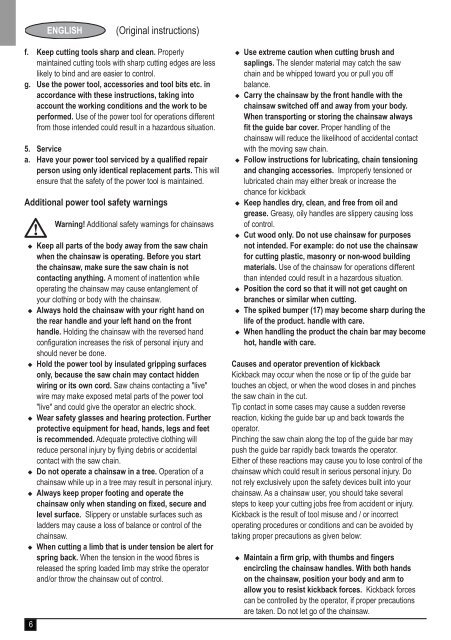BlackandDecker Tronconneuse- Gk1935 - Type 2 - Instruction Manual (Européen)
BlackandDecker Tronconneuse- Gk1935 - Type 2 - Instruction Manual (Européen)
BlackandDecker Tronconneuse- Gk1935 - Type 2 - Instruction Manual (Européen)
You also want an ePaper? Increase the reach of your titles
YUMPU automatically turns print PDFs into web optimized ePapers that Google loves.
ENGLISH<br />
(Original instructions)<br />
f. Keep cutting tools sharp and clean. Properly<br />
maintained cutting tools with sharp cutting edges are less<br />
likely to bind and are easier to control.<br />
g. Use the power tool, accessories and tool bits etc. in<br />
accordance with these instructions, taking into<br />
account the working conditions and the work to be<br />
performed. Use of the power tool for operations differ<strong>en</strong>t<br />
from those int<strong>en</strong>ded could result in a hazardous situation.<br />
5. Service<br />
a. Have your power tool serviced by a qualified repair<br />
person using only id<strong>en</strong>tical replacem<strong>en</strong>t parts. This will<br />
<strong>en</strong>sure that the safety of the power tool is maintained.<br />
Additional power tool safety warnings<br />
@<br />
6<br />
Warning! Additional safety warnings for chainsaws<br />
u Keep all parts of the body away from the saw chain<br />
wh<strong>en</strong> the chainsaw is operating. Before you start<br />
the chainsaw, make sure the saw chain is not<br />
contacting anything. A mom<strong>en</strong>t of inatt<strong>en</strong>tion while<br />
operating the chainsaw may cause <strong>en</strong>tanglem<strong>en</strong>t of<br />
your clothing or body with the chainsaw.<br />
u Always hold the chainsaw with your right hand on<br />
the rear handle and your left hand on the front<br />
handle. Holding the chainsaw with the reversed hand<br />
configuration increases the risk of personal injury and<br />
should never be done.<br />
u Hold the power tool by insulated gripping surfaces<br />
only, because the saw chain may contact hidd<strong>en</strong><br />
wiring or its own cord. Saw chains contacting a "live"<br />
wire may make exposed metal parts of the power tool<br />
"live" and could give the operator an electric shock.<br />
u Wear safety glasses and hearing protection. Further<br />
protective equipm<strong>en</strong>t for head, hands, legs and feet<br />
is recomm<strong>en</strong>ded. Adequate protective clothing will<br />
reduce personal injury by flying debris or accid<strong>en</strong>tal<br />
contact with the saw chain.<br />
u Do not operate a chainsaw in a tree. Operation of a<br />
chainsaw while up in a tree may result in personal injury.<br />
u Always keep proper footing and operate the<br />
chainsaw only wh<strong>en</strong> standing on fixed, secure and<br />
level surface. Slippery or unstable surfaces such as<br />
ladders may cause a loss of balance or control of the<br />
chainsaw.<br />
u Wh<strong>en</strong> cutting a limb that is under t<strong>en</strong>sion be alert for<br />
spring back. Wh<strong>en</strong> the t<strong>en</strong>sion in the wood fibres is<br />
released the spring loaded limb may strike the operator<br />
and/or throw the chainsaw out of control.<br />
u Use extreme caution wh<strong>en</strong> cutting brush and<br />
saplings. The sl<strong>en</strong>der material may catch the saw<br />
chain and be whipped toward you or pull you off<br />
balance.<br />
u Carry the chainsaw by the front handle with the<br />
chainsaw switched off and away from your body.<br />
Wh<strong>en</strong> transporting or storing the chainsaw always<br />
fit the guide bar cover. Proper handling of the<br />
chainsaw will reduce the likelihood of accid<strong>en</strong>tal contact<br />
with the moving saw chain.<br />
u Follow instructions for lubricating, chain t<strong>en</strong>sioning<br />
and changing accessories. Improperly t<strong>en</strong>sioned or<br />
lubricated chain may either break or increase the<br />
chance for kickback<br />
u Keep handles dry, clean, and free from oil and<br />
grease. Greasy, oily handles are slippery causing loss<br />
of control.<br />
u Cut wood only. Do not use chainsaw for purposes<br />
not int<strong>en</strong>ded. For example: do not use the chainsaw<br />
for cutting plastic, masonry or non-wood building<br />
materials. Use of the chainsaw for operations differ<strong>en</strong>t<br />
than int<strong>en</strong>ded could result in a hazardous situation.<br />
u Position the cord so that it will not get caught on<br />
branches or similar wh<strong>en</strong> cutting.<br />
u The spiked bumper (17) may become sharp during the<br />
life of the product. handle with care.<br />
u Wh<strong>en</strong> handling the product the chain bar may become<br />
hot, handle with care.<br />
Causes and operator prev<strong>en</strong>tion of kickback<br />
Kickback may occur wh<strong>en</strong> the nose or tip of the guide bar<br />
touches an object, or wh<strong>en</strong> the wood closes in and pinches<br />
the saw chain in the cut.<br />
Tip contact in some cases may cause a sudd<strong>en</strong> reverse<br />
reaction, kicking the guide bar up and back towards the<br />
operator.<br />
Pinching the saw chain along the top of the guide bar may<br />
push the guide bar rapidly back towards the operator.<br />
Either of these reactions may cause you to lose control of the<br />
chainsaw which could result in serious personal injury. Do<br />
not rely exclusively upon the safety devices built into your<br />
chainsaw. As a chainsaw user, you should take several<br />
steps to keep your cutting jobs free from accid<strong>en</strong>t or injury.<br />
Kickback is the result of tool misuse and / or incorrect<br />
operating procedures or conditions and can be avoided by<br />
taking proper precautions as giv<strong>en</strong> below:<br />
u Maintain a firm grip, with thumbs and fingers<br />
<strong>en</strong>circling the chainsaw handles. With both hands<br />
on the chainsaw, position your body and arm to<br />
allow you to resist kickback forces. Kickback forces<br />
can be controlled by the operator, if proper precautions<br />
are tak<strong>en</strong>. Do not let go of the chainsaw.
















